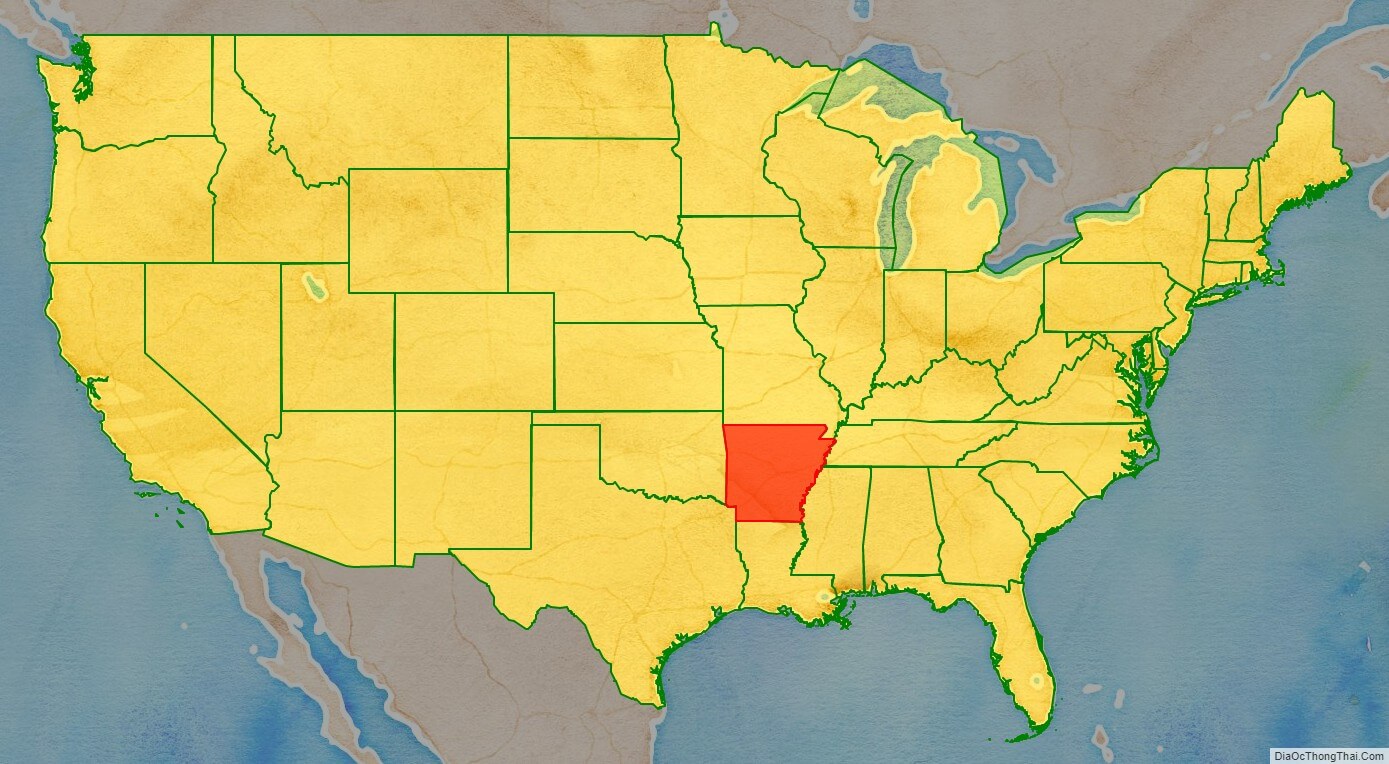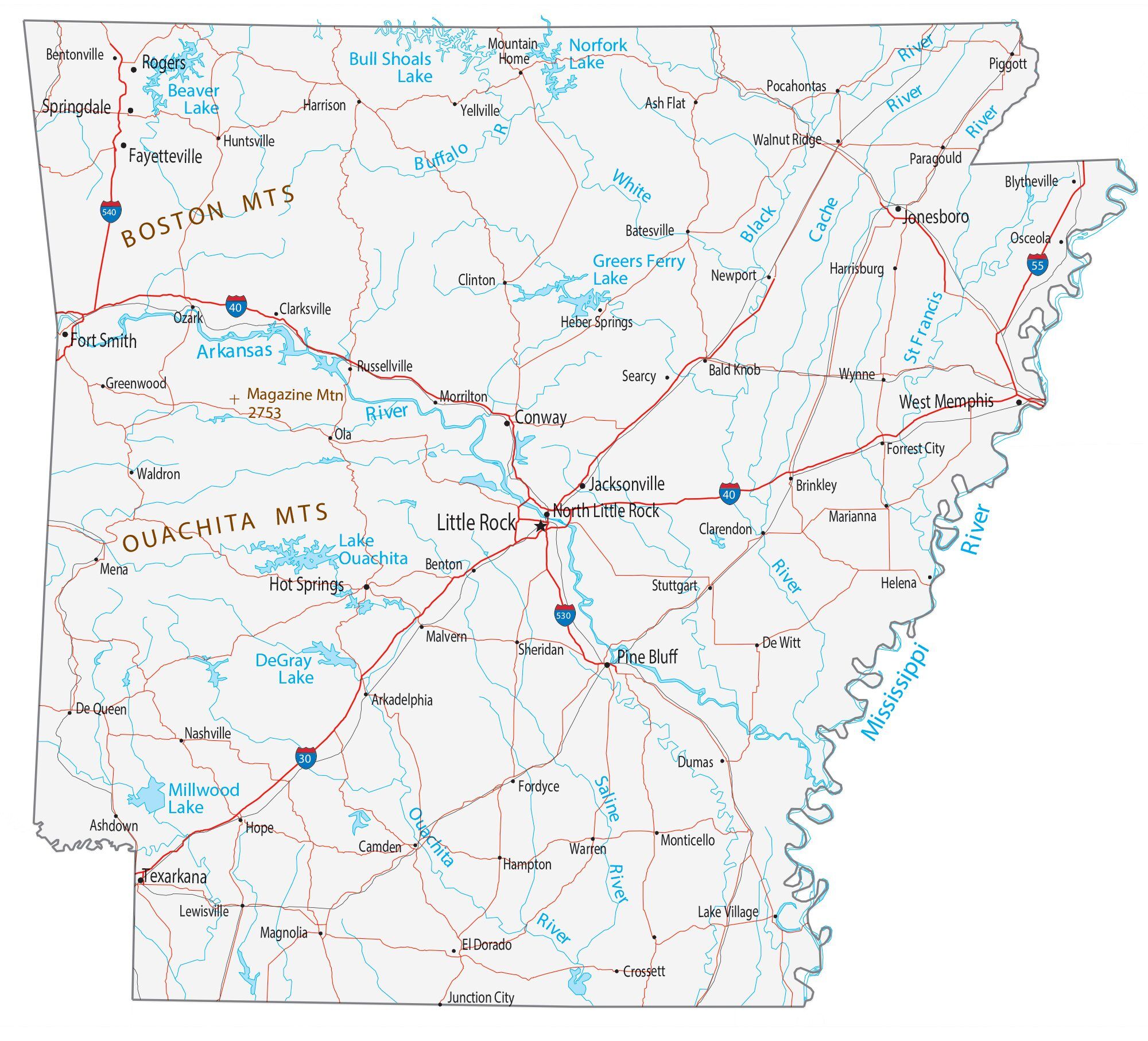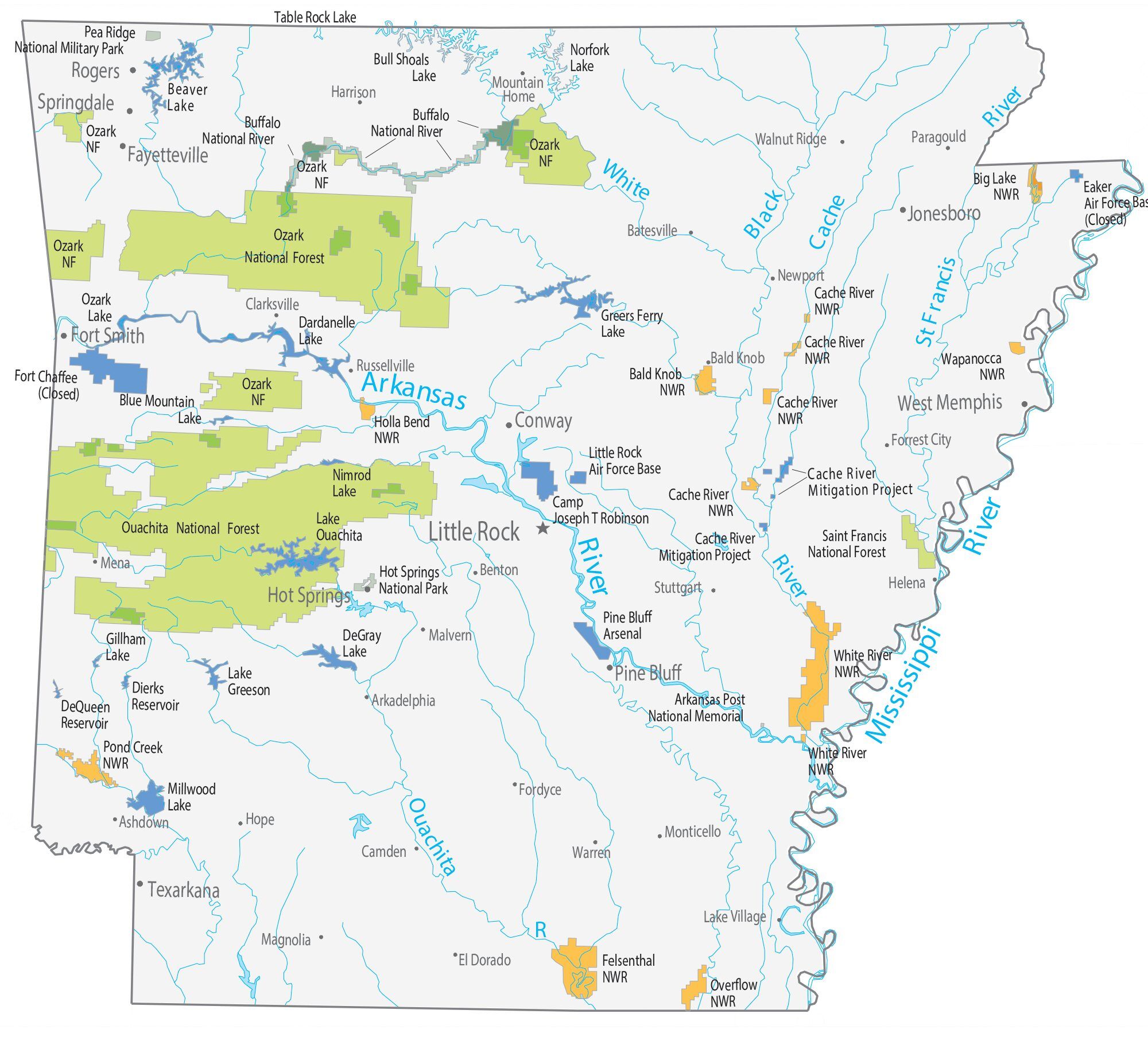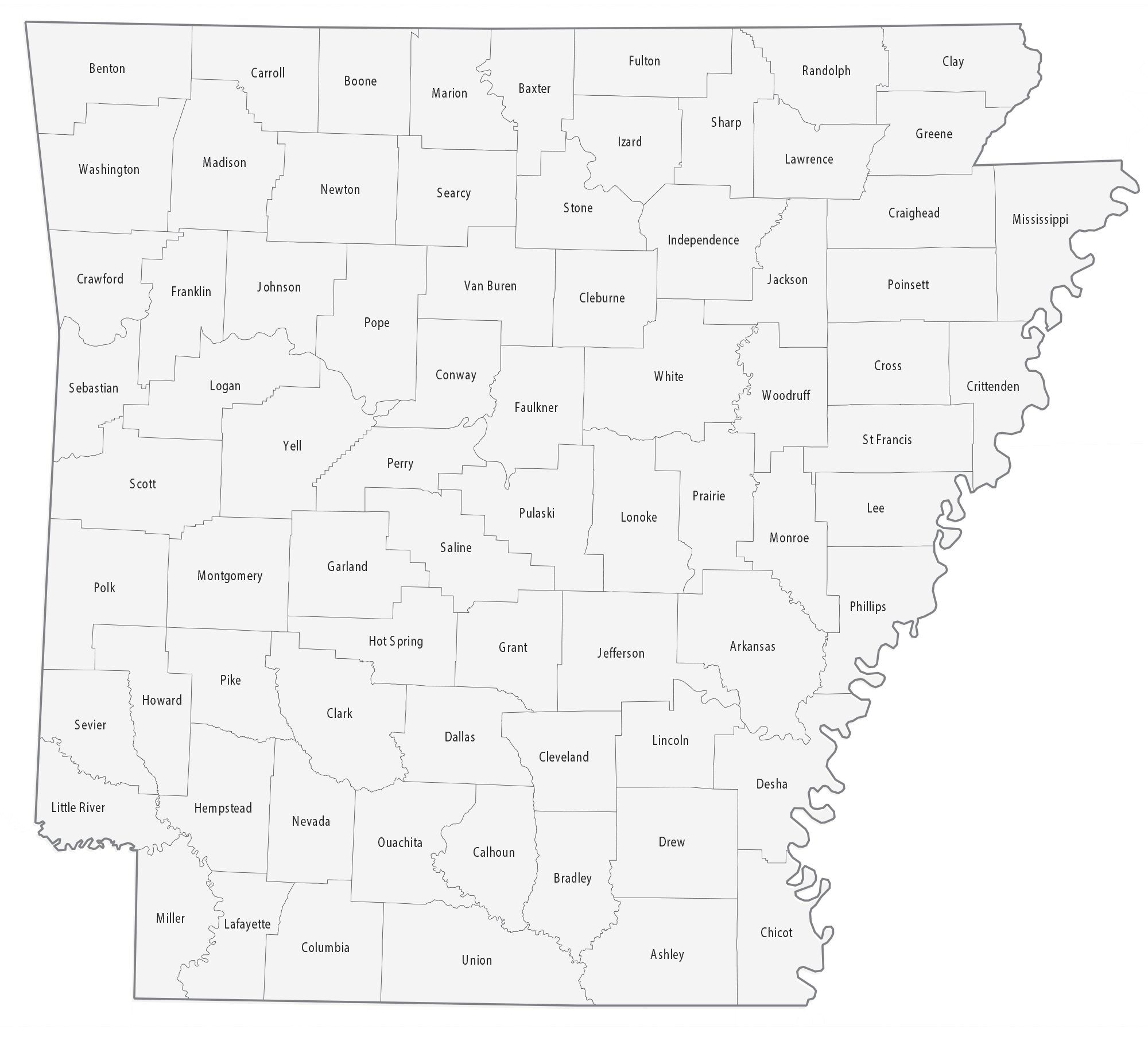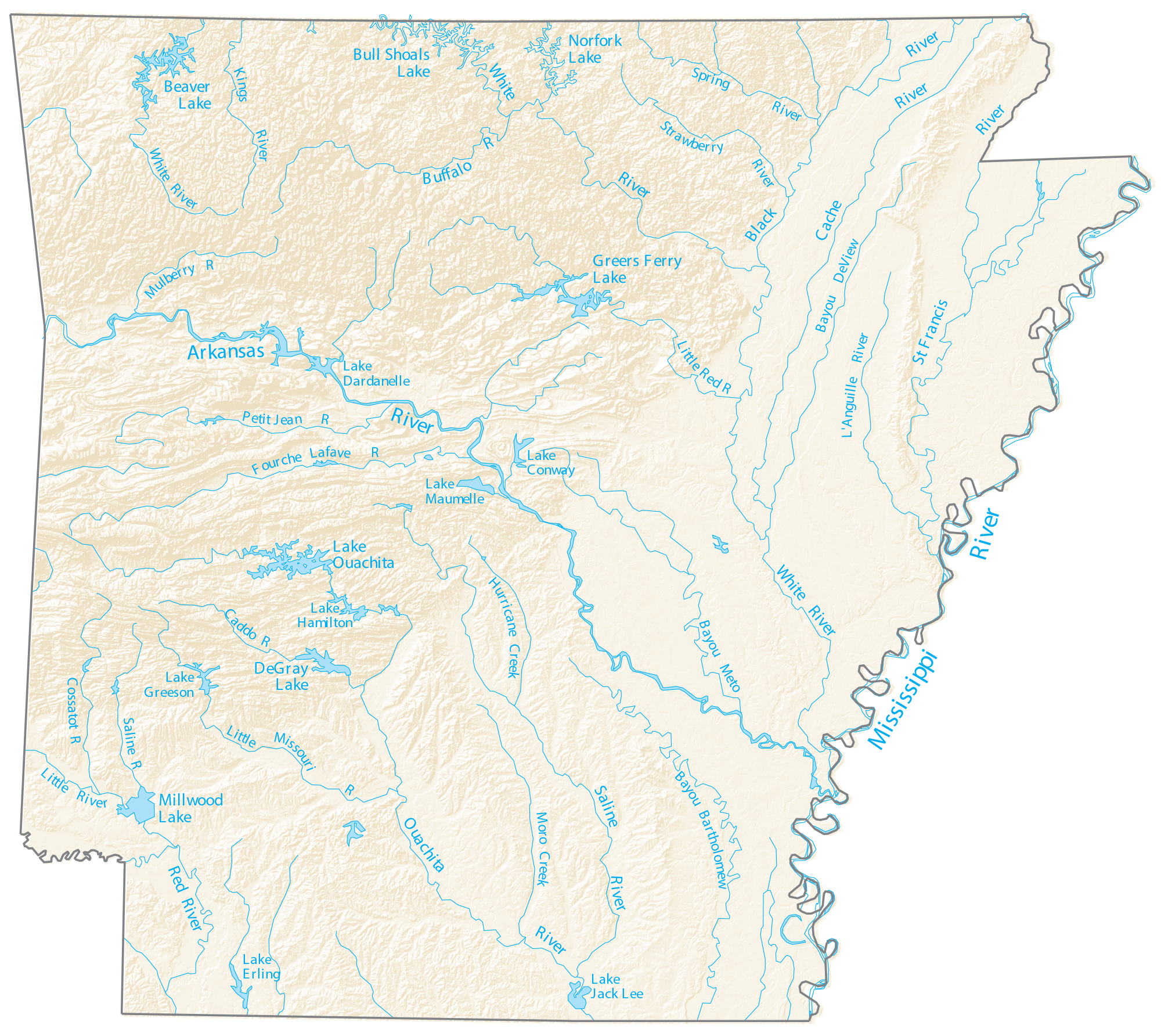Arkansas (/ˈɑːrkənsɔː/ (listen) AR-kən-saw) is a landlocked state in the south-central region of the Southern United States. It is bordered by Missouri to the north, Tennessee and Mississippi to the east, Louisiana to the south, and Texas and Oklahoma to the west. Its name is from the Osage language, a Dhegiha Siouan language, and referred to their relatives, the Quapaw people. The state’s diverse geography ranges from the mountainous regions of the Ozark and Ouachita Mountains, which make up the U.S. Interior Highlands, to the densely forested land in the south known as the Arkansas Timberlands, to the eastern lowlands along the Mississippi River and the Arkansas Delta.
Arkansas is the 29th largest by area and the 34th most populous state, with a population of just over 3 million at the 2020 census. The capital and most populous city is Little Rock, in the central part of the state, a hub for transportation, business, culture, and government. The northwestern corner of the state, including the Fayetteville–Springdale–Rogers Metropolitan Area and Fort Smith metropolitan area, is a population, education, and economic center. The largest city in the state’s eastern part is Jonesboro. The largest city in the state’s southeastern part is Pine Bluff.
Previously part of French Louisiana and the Louisiana Purchase, the Territory of Arkansas was admitted to the Union as the 25th state on June 15, 1836. Much of the Delta had been developed for cotton plantations, and landowners there largely depended on enslaved African Americans’ labor. In 1861, Arkansas seceded from the United States and joined the Confederate States of America during the American Civil War. On returning to the Union in 1868, Arkansas continued to suffer economically, due to its overreliance on the large-scale plantation economy. Cotton remained the leading commodity crop, and the cotton market declined. Because farmers and businessmen did not diversify and there was little industrial investment, the state fell behind in economic opportunity. In the late 19th century, the state instituted various Jim Crow laws to disenfranchise and segregate the African-American population. During the civil rights movement of the 1950s and 1960s, Arkansas and particularly Little Rock were major battlegrounds for efforts to integrate schools.
White interests dominated Arkansas’s politics, with disfranchisement of African Americans and refusal to reapportion the legislature. Only after the civil rights movement and federal legislation passed were more African Americans able to vote. The Supreme Court overturned rural domination in the South and other states that had refused to reapportion their state legislatures or retained rules based on geographic districts. In a series of cases in the 1960s during the height of related civil rights activities, the Warren Court invoked a one person, one vote principle, applying the Equal Protection Clause of the constitution and holding that states had to organize their legislatures by districts that held approximately equal populations, and that these had to be redefined as necessary after each decade’s census.
Following World War II in the 1940s, Arkansas began to diversify its economy and see prosperity. During the 1960s, the state became the base of the Walmart corporation, the world’s largest company by revenue, headquartered in Bentonville. In the 21st century, Arkansas’s economy is based on service industries, aircraft, poultry, steel, and tourism, along with important commodity crops of cotton, soybeans and rice.
Arkansas’s culture is observable in museums, theaters, novels, television shows, restaurants, and athletic venues across the state. Notable people from the state include politician and educational advocate William Fulbright; former president Bill Clinton, who also served as the 40th and 42nd governor of Arkansas; general Wesley Clark, former NATO Supreme Allied Commander; Walmart founder and magnate Sam Walton; singer-songwriters Johnny Cash, Charlie Rich, Jimmy Driftwood, and Glen Campbell; actor-filmmaker Billy Bob Thornton; poet C. D. Wright; physicist William L. McMillan, a pioneer in superconductor research; poet laureate Maya Angelou; Douglas MacArthur; musician Al Green; actor Alan Ladd; basketball player Scottie Pippen; singer Ne-Yo; Chelsea Clinton; actress Sheryl Underwood; and author John Grisham.
| Before statehood: | Arkansas Territory |
|---|---|
| Admitted to the Union: | June 15, 1836 (25th) |
| Capital: | Little Rock |
| Capital – largest city: | largest city |
| Largest metro and urban areas: | Central Arkansas |
| Elevation: | 650 ft (200 m) |
| Total Area: | 53,179 sq mi (137,732 km) |
| Area Rank: | 29th |
| Total Population: | 3,013,756 |
| Population Rank: | 34th |
| Population Density: | 56.4/sq mi (21.8/km) |
| Population Density Rank: | 34th |
| Median Household Income: | $49,500 |
| Income Rank: | 48th |
| Demonym(s): | ArkansanArkansawyerArkanite |
| USPS abbreviation: | AR |
| ISO 3166 code: | US-AR |
| Website: | www.arkansas.gov |
Online Interactive Map
Arkansas location map. Where is Arkansas state?
Arkansas Road Map
Arkansas Map – Roads & Cities
Arkansas Street Map
Arkansas State Map – Places and Landmarks
Arkansas Political Map
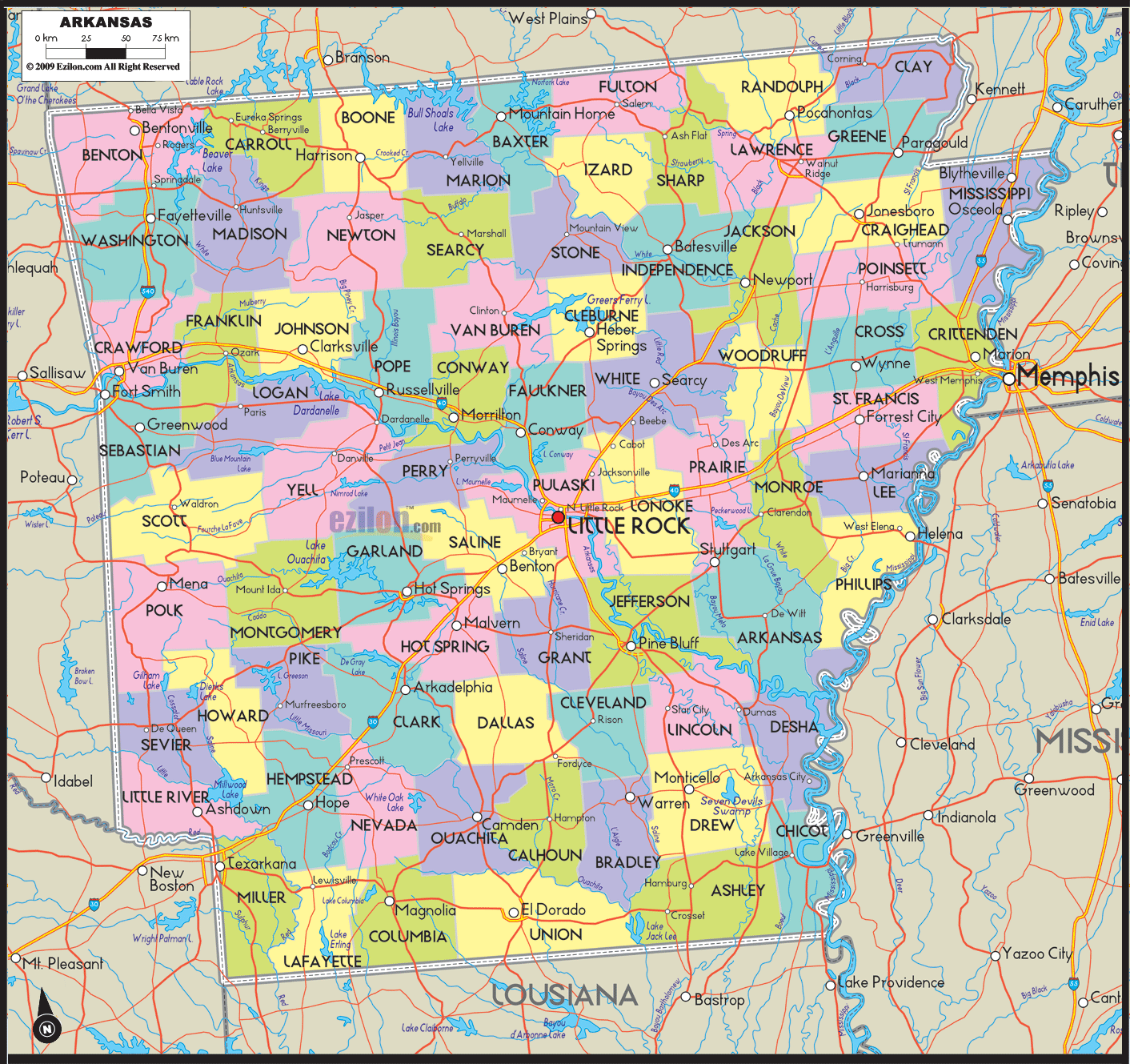
Arkansas Lakes and Rivers Map
Geography
Boundaries
Arkansas borders Louisiana to the south, Texas to the southwest, Oklahoma to the west, Missouri to the north, and Tennessee and Mississippi to the east. The United States Census Bureau classifies Arkansas as a southern state, sub-categorized among the West South Central States. The Mississippi River forms most of its eastern border, except in Clay and Greene counties, where the St. Francis River forms the western boundary of the Missouri Bootheel, and in many places where the channel of the Mississippi has meandered (or been straightened by man) from its original 1836 course.
Terrain
Arkansas can generally be split into two halves, the highlands in the northwest and the lowlands of the southeast. The highlands are part of the Southern Interior Highlands, including The Ozarks and the Ouachita Mountains. The southern lowlands include the Gulf Coastal Plain and the Arkansas Delta. This split can yield to a regional division into northwest, southwest, northeast, southeast, and central Arkansas. These regions are broad and not defined along county lines. Arkansas has seven distinct natural regions: the Ozark Mountains, Ouachita Mountains, Arkansas River Valley, Gulf Coastal Plain, Crowley’s Ridge, and the Arkansas Delta, with Central Arkansas sometimes included as a blend of multiple regions.
The southeastern part of Arkansas along the Mississippi Alluvial Plain is sometimes called the Arkansas Delta. This region is a flat landscape of rich alluvial soils formed by repeated flooding of the adjacent Mississippi. Farther from the river, in the southeastern part of the state, the Grand Prairie has a more undulating landscape. Both are fertile agricultural areas. The Delta region is bisected by a geological formation known as Crowley’s Ridge. A narrow band of rolling hills, Crowley’s Ridge rises 250 to 500 feet (76 to 152 m) above the surrounding alluvial plain and underlies many of eastern Arkansas’s major towns.
Northwest Arkansas is part of the Ozark Plateau including the Ozark Mountains, to the south are the Ouachita Mountains, and these regions are divided by the Arkansas River; the southern and eastern parts of Arkansas are called the Lowlands. These mountain ranges are part of the U.S. Interior Highlands region, the only major mountainous region between the Rocky Mountains and the Appalachian Mountains. The state’s highest point is Mount Magazine in the Ouachita Mountains, which is 2,753 feet (839 m) above sea level.
Arkansas is home to many caves, such as Blanchard Springs Caverns. The State Archeologist has catalogued more than 43,000 Native American living, hunting and tool-making sites, many of them Pre-Columbian burial mounds and rock shelters. Crater of Diamonds State Park near Murfreesboro is the world’s only diamond-bearing site accessible to the public for digging. Arkansas is home to a dozen Wilderness Areas totaling 158,444 acres (641.20 km). These areas are set aside for outdoor recreation and are open to hunting, fishing, hiking, and primitive camping. No mechanized vehicles nor developed campgrounds are allowed in these areas.
Hydrology
Arkansas has many rivers, lakes, and reservoirs within or along its borders. Major tributaries to the Mississippi River include the Arkansas River, the White River, and the St. Francis River. The Arkansas is fed by the Mulberry and Fourche LaFave Rivers in the Arkansas River Valley, which is also home to Lake Dardanelle. The Buffalo, Little Red, Black and Cache Rivers are all tributaries to the White River, which also empties into the Mississippi. Bayou Bartholomew and the Saline, Little Missouri, and Caddo Rivers are all tributaries to the Ouachita River in south Arkansas, which empties into the Mississippi in Louisiana. The Red River briefly forms the state’s boundary with Texas. Arkansas has few natural lakes and many reservoirs, such as Bull Shoals Lake, Lake Ouachita, Greers Ferry Lake, Millwood Lake, Beaver Lake, Norfork Lake, DeGray Lake, and Lake Conway.
Flora and fauna
Arkansas’s temperate deciduous forest is divided into three broad ecoregions: the Ozark, Ouachita-Appalachian Forests, the Mississippi Alluvial and Southeast USA Coastal Plains, and the Southeastern USA Plains. The state is further divided into seven subregions: the Arkansas Valley, Boston Mountains, Mississippi Alluvial Plain, Mississippi Valley Loess Plain, Ozark Highlands, Ouachita Mountains, and the South Central Plains. A 2010 United States Forest Service survey determined 18,720,000 acres (7,580,000 ha) of Arkansas’s land is forestland, or 56% of the state’s total area. Dominant species in Arkansas’s forests include Quercus (oak), Carya (hickory), Pinus echinata (shortleaf pine) and Pinus taeda (loblolly pine).
Arkansas’s plant life varies with its climate and elevation. The pine belt stretching from the Arkansas delta to Texas consists of dense oak-hickory-pine growth. Lumbering and paper milling activity is active throughout the region. In eastern Arkansas, one can find Taxodium (cypress), Quercus nigra (water oaks), and hickories with their roots submerged in the Mississippi Valley bayous indicative of the deep south. Nearby Crowley’s Ridge is the only home of the tulip tree in the state, and generally hosts more northeastern plant life such as the beech tree. The northwestern highlands are covered in an oak-hickory mixture, with Ozark white cedars, cornus (dogwoods), and Cercis canadensis (redbuds) also present. The higher peaks in the Arkansas River Valley play host to scores of ferns, including the Woodsia scopulina and Adiantum (maidenhair fern) on Mount Magazine. Arkansas wildlife is famous for the white-tailed deer, elk, and bald eagle. The white-tailed deer is the official state mammal.
Climate
Arkansas generally has a humid subtropical climate. While not bordering the Gulf of Mexico, Arkansas, is still close enough to the warm, large body of water for it to influence the weather in the state. Generally, Arkansas, has hot, humid summers and slightly drier, mild to cool winters. In Little Rock, the daily high temperatures average around 93 °F (34 °C) with lows around 73 °F (23 °C) in July. In January highs average around 51 °F (11 °C) and lows around 32 °F (0 °C). In Siloam Springs in the northwest part of the state, the average high and low temperatures in July are 89 and 67 °F (32 and 19 °C) and in January the average high and low are 44 and 23 °F (7 and −5 °C). Annual precipitation throughout the state averages between about 40 and 60 inches (1,000 and 1,500 mm); it is somewhat wetter in the south and drier in the northern part of the state. Snowfall is infrequent but most common in the northern half of the state. The half of the state south of Little Rock is apter to see ice storms. Arkansas’s record high is 120 °F (49 °C) at Ozark on August 10, 1936; the record low is −29 °F (−34 °C) at Gravette, on February 13, 1905.
Arkansas is known for extreme weather and frequent storms. A typical year brings thunderstorms, tornadoes, hail, snow and ice storms. Between both the Great Plains and the Gulf States, Arkansas, receives around 60 days of thunderstorms. Arkansas is located in Tornado Alley, and as a result, a few of the most destructive tornadoes in U.S. history have struck the state. While sufficiently far from the coast to avoid a direct hit from a hurricane, Arkansas can often get the remnants of a tropical system, which dumps tremendous amounts of rain in a short time and often spawns smaller tornadoes.
Cities and towns
Little Rock has been Arkansas’s capital city since 1821 when it replaced Arkansas Post as the capital of the Territory of Arkansas. The state capitol was moved to Hot Springs and later Washington during the American Civil War when the Union armies threatened the city in 1862, and state government did not return to Little Rock until after the war ended. Today, the Little Rock–North Little Rock–Conway metropolitan area is the largest in the state, with a population of 724,385 in 2013.
The Fayetteville–Springdale–Rogers Metropolitan Area is the second-largest metropolitan area in Arkansas, growing at the fastest rate due to the influx of businesses and the growth of the University of Arkansas and Walmart.
The state has eight cities with populations above 50,000 (based on 2010 census). In descending order of size, they are Little Rock, Fort Smith, Fayetteville, Springdale, Jonesboro, North Little Rock, Conway, and Rogers. Of these, only Fort Smith and Jonesboro are outside the two largest metropolitan areas. Other cities in Arkansas include Pine Bluff, Crossett, Bryant, Lake Village, Hot Springs, Bentonville, Texarkana, Sherwood, Jacksonville, Russellville, Bella Vista, West Memphis, Paragould, Cabot, Searcy, Van Buren, El Dorado, Blytheville, Harrison, Dumas, Rison, Warren, and Mountain Home.
Arkansas Physical Map
Arkansas Topographic Map
Arkansas Satellite Map
Others printable maps
Arkansas Outline Map
Blank Arkansas County Map
See also
Map of Arkansas State and its subdivision:- Arkansas
- Ashley
- Baxter
- Benton
- Boone
- Bradley
- Calhoun
- Carroll
- Chicot
- Clark
- Clay
- Cleburne
- Cleveland
- Columbia
- Conway
- Craighead
- Crawford
- Crittenden
- Cross
- Dallas
- Desha
- Drew
- Faulkner
- Franklin
- Fulton
- Garland
- Grant
- Greene
- Hempstead
- Hot Spring
- Howard
- Independence
- Izard
- Jackson
- Jefferson
- Johnson
- Lafayette
- Lawrence
- Lee
- Lincoln
- Little River
- Logan
- Lonoke
- Madison
- Marion
- Miller
- Mississippi
- Monroe
- Montgomery
- Nevada
- Newton
- Ouachita
- Perry
- Phillips
- Pike
- Poinsett
- Polk
- Pope
- Prairie
- Pulaski
- Randolph
- Saint Francis
- Saline
- Scott
- Searcy
- Sebastian
- Sevier
- Sharp
- Stone
- Union
- Van Buren
- Washington
- White
- Woodruff
- Yell
- Alabama
- Alaska
- Arizona
- Arkansas
- California
- Colorado
- Connecticut
- Delaware
- District of Columbia
- Florida
- Georgia
- Hawaii
- Idaho
- Illinois
- Indiana
- Iowa
- Kansas
- Kentucky
- Louisiana
- Maine
- Maryland
- Massachusetts
- Michigan
- Minnesota
- Mississippi
- Missouri
- Montana
- Nebraska
- Nevada
- New Hampshire
- New Jersey
- New Mexico
- New York
- North Carolina
- North Dakota
- Ohio
- Oklahoma
- Oregon
- Pennsylvania
- Rhode Island
- South Carolina
- South Dakota
- Tennessee
- Texas
- Utah
- Vermont
- Virginia
- Washington
- West Virginia
- Wisconsin
- Wyoming

